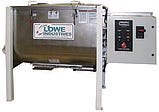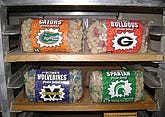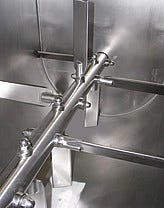February 25, 2010
Since 1994, the Pasta Shoppe in Nashville, TN has been making more than 45 different themed pasta shapes including "Home Sweet Home" and "Cold Cash." That same year they kicked off the manufacture of various college and university mascots and logo shapes.
Whatever the shape, the all-natural pasta kicks off with 100 lb of fresh, high-glutton, durum wheat Semolina flour. For batches where color is necessary, a tomato-based color for example, a powdered colorant is added. Egg whites are then added with very little water, with the goal of being not too wet and not too dry. "we need the dough mixture just right to be able to pull it through our tooling equipment to end up with a really strong shape that's still wet," says Pasta Shoppe president and CEO, John Aron.
|
Lowe mixing system with pneumatically actuated contour slide discharge valve |
After the dough has been mixed, it is run through a specific dye to obtain the shape. The key with the dough mixture is to develop a porous noodle because that soaks up more sauce. Pasta Shoppe has it down to a science, packaging up to a million pieces of unusual pasta every day. They have a selection that cannot be found anyplace else. It is their niche market.
Business Situation
Pasta Shoppe was previously mixing pasta dough in two smaller mixers that took too long to process. Batch quantities were necessary to meet a demand of over a million pasta pieces per day. Pasta Shoppe’s objectives were:
* Shorter Mix Times
* Increased Production Reliability
* Faster Dough Development
* Reduction in Energy Consumption
* Increased Automation
Pasta Shoppe contacted Lowe Industries, who manufacture stainless-steel mixing equipment for the processing industry.
Technical Situation
During the development of the pasta dough mixer design, Lowe consulted with industry expert Carlo Varesco, who has worked within the United States pasta industry for more than 45 years. Together, Lowe and Varesco designed and built a portable test mixer for use by prospective customers.
Based on Pasta Shoppe’s application requirements, the test mixer was modified with the appropriate configuration of agitator, liquid addition spray manifold system, and integral control panel. A free trial mixer was scheduled and shipped to the Pasta Shoppe plant in Nashville for a three-week test.
in Nashville for a three-week test. In addition, Lowe sales engineer, Jeff Evans visited the Pasta Shoppe plant to learn more about its processing system. “These events are part of our exclusive six-step development process,” said Evans. The six steps are:
1. Identifying Needs
2. Research
3. Testing
4. Design
5. Custom Manufacture
6. Customer Service
Challenges
Some unique challenges that Pasta Shoppe had that required custom design mixer solutions included the following:
1. Dough Movement – Making sure agitator paddles are aligned for balanced placement and pitch.
2. Cleanup Challenges – Labor content on a 20-min. mix, post flour dumping, is about three minutes of scraping and three minutes of pushing bottom of hopper dough into the discharge hole. In addition, endof- day scrape down of the paddles could take up to 35 minutes.
3. Efficient liquid addition dough hydration system – Cost-effective, low-maintenance water intake system with best spraying system to make required dough consistency.
4. Batch discharge system – Efficient system of discharging and processing dough once it leaves the mixer.
5. Prefer to purchase a U.S.-made mixer.
|
Pasta Shoppe gourmet pasta products |
““The key to success for the Pasta Shoppe product application involved our learning the pasta dough making process,” said Evans. “We first had to understand how the semolina flour absorbs water, learn about its granulometry, and discover how to provide sufficient hydration during the dough making process even before we set out to design the equipment. To accomplish this, our team did some lab testing to better understand how our equipment would complement the science of dough making.”
Solution
Adjustable paddles. Changing the paddle position was not a tough job for Pasta Shoppe. Adjustment is often needed to get the product flow to look right and to achieve the best pitch for trough wall scraping. Specially designed cleanup tools can be fabricated if necessary.
The Lowe team invested in a considerable amount of research to determine the number of paddle blades, movement configuration, and pitch and trough wall clearance positioning to meet Pasta Shoppe’s product requirements. The solution involved a custom “push-pull” mixing design that allowed the product to be pulled across the trough for thorough mixing and hydration.
Dough Hydration. After considering various water intake pumping systems, the system chosen for Pasta Shoppe involved a metered intake from its municipal water line at the plant. Testing of the liquid addition system provided a successful solution for Pasta Shoppe as well. A pair of flood-jet nozzles was positioned at just the right distance from the product level with the spray pattern shooting downward into the product on the upsweep side (high product level side). By careful placement of the nozzles, the pattern width of 46 to 47 in. was accomplished for thorough product hydration of a 400-lb batch. The addition rate can be regulated from the intake line to modulate the spray, allowing for adjustments to the system.
|
Sanitary-compliant adjustable paddle agitator |
Batch Discharge System. One goal of Pasta Shoppe was to get the batch mixing time from 25 to 20 minutes and thoroughly discharged, with incorporating other processing features to achieve a more lean processing system. One of the benefits of a Lowe Industries mixing system is the many features that can be custom-manufactured to support a lean process. Some of those features that were designed for Pasta Shoppe included:
* Pneumatically actuated contour slide discharge valve with bottom center discharge positioned to accommodate a stainless- steel pallet for support of a product tote.
* Structural Legs – Bolted structural angle iron legs with 15-in. clearance between discharge outlet and stainless-steel pallet.
* Electrical Controls – Including NEMA 4 (washdown) enclosure, suitable for 240 V, 3-phase primary voltage, low-voltage control circuit, 10-hp motor starter, pushbutton start/stop/emergency, panel-mounted amp meter, pushbutton discharge open/close (closes discharge after cleaning), and prewired at plant.
* Custom Safety-Grate and Cover to allow easy-dry ingredient addition and minimize dusting. Both the grate and cover were Sanitary-compliant adjustable paddle agitator hinged to allow for quick cleaning between batches.
Benefits
�“Our innovative agitator designs enable shorter mix times, higher productivity, and lower maintenance costs,” says Evans. “Another benefit of our pasta dough mixer is that it is U.S.-engineered, sold, and serviced. Domestically this eliminates the shipping, currency, and communication barriers of the ‘Italian-made machines’.”
Lowe Industries is a product line of Marion Mixers IA), specializing (Marion, mixing in and blending equipment industries for such as food, spice, dairy, pharmaceutical, pigment, and plastic, where sanitation of is primary Mixers concern. and blenders available are in both ribbon and paddle-style agitators. A free, trial 21-day mixer available is to performance gather and process during data the initial stages of a project provide and a performance guarantee to prospective customers. For more information, visit www.lowemixers.com.
You May Also Like





